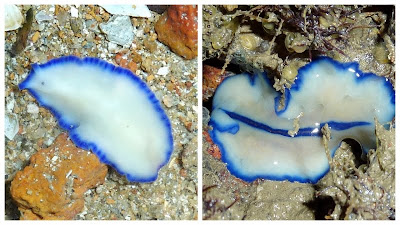Why date the post 2010? As explained in last year's post on Sekudu, I seemed to only get to visit this island annually. My first trip was in 2007 followed by the one in 2008.
The legend of the Frog Island, also known as Pulau Sekudu, goes where a pig, elephant and frog wanted to swim to Johor. They did not made it eventually and all turned into Ketam, Ubin and Sekudu respectively. The rock formation at the island is spectacular and one of which looks like the fossilized frog of the legend.
More photos of these special rocks at Sekudu at Dr Chua's website and explanations at Joseph Lai's Earth website.
Not only is Pulau Sekudu a special yet small island with lots of rocks, the island seems to be expanded many times during low tide exposing a wide variety of marine life like the many sea stars you see here.
Once in a while, one can spot bigger stars like this large sized Biscuit sea star (Gonodiscaster scaber).

Sea stars of Sekudu can be brightly coloured like this orange Crown sea star (Asterina coronata) on the left and a juvenile Cake sea star (Anthenea aspera) on the right.
However, their abundance seemed to have dropped, similar to what was seen at Changi recently. Is it a seasonal thing?

Jane and Alyce found this Common sea star (Archaster typicus), which is my second time seeing it in Sekudu. My first sighting of this was last year. Geraldine said she saw many prints on the sand so there's definitely more than one.
Geraldine is getting more experienced in spotting stuffs and I'm glad she found a red stunning Knobbly sea star (Protoreaster nodosus).

And Jane later also found another! This one is much much smaller, a juvenile that has a tinge of green on its brown body.
That's really quite a number of the different types of stars for today.
More echinoderms found today will be the many White sea urchins (Salmacis sp.) found especially at the coral rubble area. It's been some time I've seen so many at one go.

Mei Lin and Geraldine found this super tiny weeny Pencil sea urchin (Prionocidaris sp.). Compare its size to the Oval Seagrass! This must be the tiniest I've ever seen.
The special cake sand dollar of the day must be this Pink sand dollar (Peronella lesueuri)! I've only seen them at Sekudu once before. Ria saw it once at Changi previously.
A first echinoderm sighting for me at Sekudu will be this Synaptic sea cumuber. They are usually only more commonly found in the Southern shores.

Moving on to flatworms, we encountered a couple of them that seem to be of similar species in terms of colour but they are different. The one on the left is the Blue-spotted flatworm (Pseudoceros indicus) with blue dots at the edge while the Blue-lined flatworm (Pseudoceros sp.) on the right has continue blue edge and a centre blue line across.
But the happiest flatworm find must be this Little ruby flatworm (Phrikoceros baibaiye)! It is my first time seeing this stunning flatworm. On its orange body are many white spots. Near to its head is a short white line. I saw two of these today! :)
Moving on to slugs, Jane and Alyce's sharp eyes spotted this Denison's nudibranch (Dendrodoris denisoni).
But the best slug find of the day must be this first sighting of an unknown species of the Gymnodoris nudibranch (Gymnodoris sp.). Shall wait for Chay Hoon to find the exact species and update here asap.
Chay Hoon once again topped the list of finding slugs with this super tiny slug that looks like a leaf slug with long tentacles. We have no idea what this is either.

Another first time find of slug for me personally will be this Volvatella slug (Volvatella vigourouxi). It eats Caulerpa green seaweeds and thus are normally found on these seaweeds.
I had a quick look at the coral rubble area and noticed the number of the Posy anemones has increased quite a lot at certain areas. There are also some fan worms and small sponges among the pool of anemones.

Something new for Sekudu this year will be the recruitment of many of these Ball flowery soft corals which starts to resemble a bit of Beting Bronok.
Last but not least, I found this rare Watering pot shell (Brechites penis) towards the end of the trip. The broader end of this bivalve is perforated with tiny holes and lies flush with the surface to filter feed. The broader end resembles a watering can, hence its common name.
Though the coral rubble is no compare to what its former glory before the mass flooding event in January 2007, I'm still glad to know that life continue to persist. Till the next trip, goodbye froggy!
Sunday, May 16, 2010
The froggy Sekudu 2010
Subscribe to:
Post Comments (Atom)


















No comments:
Post a Comment